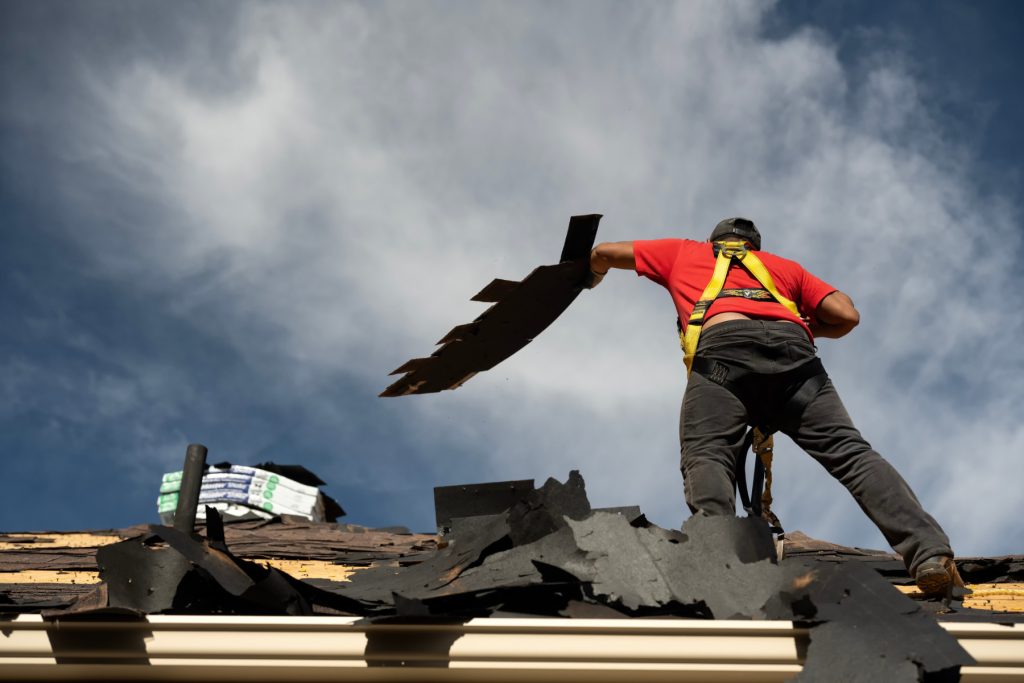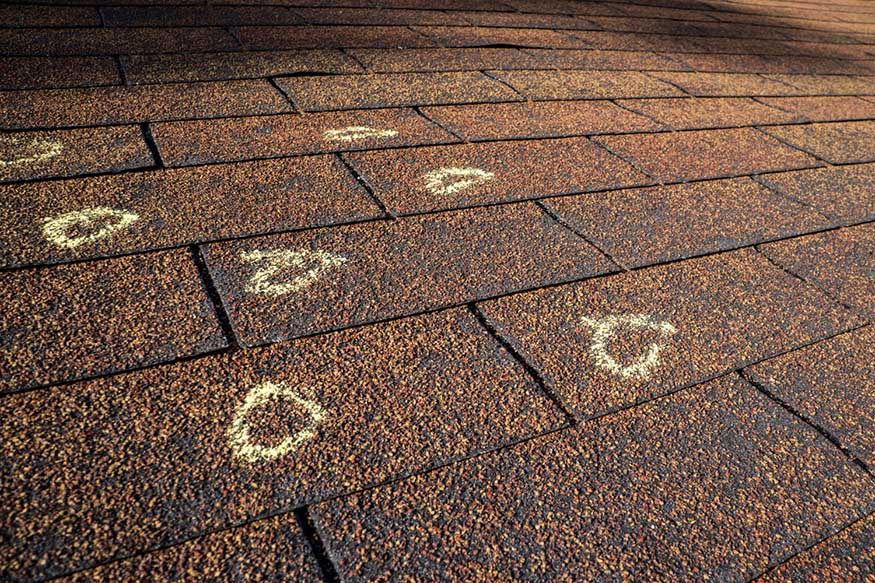Hailstorms in Winnipeg can be terrifying events, causing a lot of hail damage to property in a short amount of time. One of the most vulnerable parts of your house during a hailstorm is your roof. If you think your roof has been damaged in a hailstorm, it’s important to take action right away to prevent further damage and protect your Winnipeg home. Today we want to walk you through the steps you should take to assess the damage, file an insurance claim, and get your roof repaired.
How to Spot Hail Damage
The signs of hail damage on your roof will vary depending on the type of roofing material you have. Here’s a breakdown of what to look for on common roofing materials:
- Asphalt Shingles: Asphalt shingles are the most common type of roofing material in North America. Hail can damage asphalt shingles in a number of ways, including cracking, bruising, or dislodging them entirely. You may also see granules (the small pebbles that coat the shingles) in your gutters after a hailstorm. This is a sign that the shingles have been damaged and are losing their protective layer.
- Wood Shingles: Wood shingles are more susceptible to hail damage than asphalt shingles. Hail can split, crack, or break wood shingles. If you have a wood shingle roof, it’s important to inspect it carefully after a hailstorm for any signs of damage.
- Metal Shingles: Metal roofs are generally more durable than other types of roofing materials. However, hail can still dent or puncture metal shingles. If you have a metal roof, look for any dents, punctures, or popped fasteners after a hailstorm.
Why You Should Fix Your Roof Right Away

Even if your roof isn’t leaking after a hailstorm, it’s important to get hail damage repaired as soon as possible. Hail damage can weaken your roof and make it more susceptible to future damage from wind, rain, and snow. Left unrepaired, hail damage can also lead to more serious problems, such as water damage, mold growth, and structural damage. Additionally, hail damage can lower the value of your home. So, if you think your roof has been damaged in a hailstorm, don’t delay in getting it repaired.
5 Steps to Take After Hail Damage
- Inspect Your Roof (Safely): If it’s safe to do so, climb onto your roof and look for signs of hail damage. Be careful not to walk on damaged areas of your roof, as you could fall through. It’s important to prioritize your safety. If you’re not comfortable inspecting your roof yourself, you can hire a professional roofer to do it for you.
- Document the Damage: Take pictures and videos of any damage you find on your roof. These photos and videos will be helpful when you file an insurance claim. In addition to taking photos of the damage itself, also take photos of the surrounding area, including the date and time stamp. This will help to document the extent of the hailstorm and the damage it caused.
- Contact Your Insurance Company: File a claim with your insurance company as soon as possible. Your homeowner’s insurance policy should cover hail damage to your roof. However, it’s important to review your policy carefully to understand your specific coverage. When you file your claim be prepared to provide the date of the hailstorm, the location of the damage, and a description of the damage.
- Contact A Roofing Company: Once you have your insurance company’s approval to proceed, get estimates from qualified roofers. Be sure to get at least three estimates before you hire a roofer. When getting estimates, ask the roofers about their experience repairing hail damage, the materials they will use, and the warranty on their work.
- Roofing Repairs: Have the roofer repair the damage according to your insurance company’s specifications. It’s important to use a qualified and reputable roofer to repair your hail damage. Don’t be tempted to hire the cheapest roofer you can find. A quality roof repair job is an investment in your home.
5 Things to Know About the Insurance Claim Process for Hail Damage

Understanding how to navigate the insurance claim process can be crucial in getting your roof repaired and restored after a damaging storm. Here are 5 key things to keep in mind:
- Timeliness Is Key: File your claim with your insurance company promptly. Most policies have time limits for when you can report damage. Early reporting helps speed up the process and prevent any coverage issues.
- Thorough Documentation: The success of your claim often hinges on how well you document the damage. Take extensive photos and videos, not just of the roof itself, but the surrounding property as well.
- The Adjuster’s Role: Before the adjuster arrives, review your homeowner’s insurance policy carefully. Understand your deductible, what’s covered, and if there are any exclusions for specific types of roof damage. The insurance adjuster will assess the damage to confirm it aligns with your claim and determine the payout amount. It’s helpful to have a reputable roofing contractor present for a second opinion. No matter what your insurance company or roofing contractor may say, the insurance adjuster is the only one who can approve your claim.
- Don’t Sign Without Approval: Never sign off on repairs or accept a settlement without ensuring your claim is fully approved. Work with your roofing contractor to ensure their estimate aligns with the insurance adjuster’s assessment.
- Choose A Roofing Company to Make the Repairs: Only after your claim has been approved, you can hire a local roofing company to do the repairs. It’s important to find a roofing company that has experience working with insurance claims, and can smoothly help you through the process. Make sure the roofing company has high-quality workmanship and a reputable reputation. In the end, you don’t just need a roofing company to repair the roof damage, you need a roofing company with a willingness to fight for your best interest during the insurance process. At Above All we do both!
Hailstorms can be unpredictable and destructive, and it’s wise to be prepared for the aftermath. Understanding the potential signs of hail damage and knowing what steps to take can help you minimise further damage and protect your home. By following these guidelines and steps, you can navigate getting your roof repaired and process an insurance claim after a hailstorm. Here at Above All, we want to ensure your home is restored to its best condition.
Contact us for a free roofing quote today. Let us be your go-to roofing contractor after a spring or summer hail storm this season!
Additional Tips
- Don’t Delay: It’s crucial to address hail damage promptly. The longer you wait, the greater the risk of secondary damage to your home.
- Vet Your Contractor: Choose a reputable roofing contractor who has experience in dealing with hail damage repairs. Look for certifications and check online reviews.
- Understand Your Insurance Coverage: Read your homeowner’s insurance policy carefully to know exactly what’s covered. Be familiar with your deductible and any time limits for filing a claim.
FAQ
Q: What size hail will damage a roof?
Answer: The size of hail that can damage a roof will vary depending on the type of roofing material you have. However, hail as small as half an inch in diameter can damage asphalt shingles.
Q: How do I protect my roof from hail?
Answer: Have a professional roof inspection done at least once a year to identify and address any potential weaknesses. Ensure your roof is in good condition by fixing minor problems, like loose shingles, as soon as they occur. If you live in an area prone to hailstorms, consider investing in impact-resistant roofing materials.
Q: How much damage can hail cause?
Answer: Hail can cause a variety of damage to your roof, including cracks, bruises, dents, and punctures. In severe cases, hail can even cause holes in your roof. Hail damage can also affect the underlying structure of your roof, such as the roof deck or the trusses. Additionally, hail can damage other parts of your home’s exterior, such as your gutters, siding, and windows.
Q: How do you protect skylights from hail damage?
Answer: Choose skylights specifically designed to withstand hail. These skylights typically have acrylic or polycarbonate glazing, which is more impact-resistant than glass. Consider using a skylight cover during severe weather. Even placing plywood or heavy blankets over your skylights can provide some protection.